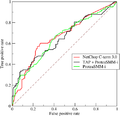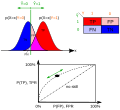Receiver operating characteristic
Receiver Operating Characteristic (ROC) is a graphical plot that illustrates the diagnostic ability of a binary classifier system as its discrimination threshold is varied. The ROC curve is created by plotting the true positive rate (TPR) against the false positive rate (FPR) at various threshold settings. The true positive rate is also known as sensitivity, recall or probability of detection in machine learning. The false positive rate is also known as the probability of false alarm and can be calculated as (1 - specificity).
Definition[edit]
The ROC curve represents a fundamental tool for diagnostic test evaluation. In a ROC curve, the true positive rate (Sensitivity) is plotted on the Y axis, while the false positive rate (1-Specificity) is plotted on the X axis. An area under the ROC curve (AUC) is used as a measure of the overall performance of a diagnostic test and ranges from 0 to 1. An AUC of 0.5 suggests no discriminative ability (equivalent to random guessing), while an AUC of 1.0 indicates perfect discrimination.
History[edit]
The concept of ROC originated from signal detection theory, which was developed during World War II for the analysis of radar signals before it was introduced into psychology and subsequently into medicine and diagnostic radiology for evaluating the trade-offs between hit rates and false alarm rates of diagnostic tests.
Applications[edit]
ROC analysis is widely used in medicine, radiology, biometrics, and various fields of machine learning and data mining to evaluate the performance of diagnostic tests, classifiers, and predictive models. It is particularly useful for determining the optimal cut-off value for a test and comparing the diagnostic performance of two or more tests or models.
Calculating the ROC Curve[edit]
To construct an ROC curve, a series of thresholds is applied to a test result or a predictive model to calculate the true positive rate (sensitivity) and false positive rate (1-specificity) for each threshold. These rates are then plotted on a graph.
Interpretation[edit]
- AUC: The area under the ROC curve quantifies the overall ability of the test to discriminate between those individuals with the disease and those without. An AUC closer to 1 indicates a better test. - Cut-off Point: The choice of the threshold affects the test's sensitivity and specificity. There is usually a trade-off between these two measures. - ROC Space: Points in the upper left corner of the ROC space represent good classification results, while points along the diagonal represent random guessing.
Advantages and Limitations[edit]
Advantages: - The ROC curve is independent of the class distribution, making it useful for evaluating diagnostic tests in various conditions. - It allows for the comparison of the diagnostic performance of multiple tests.
Limitations: - ROC analysis can be overly optimistic in case of highly imbalanced datasets. - It does not account for the cost of false positives and false negatives.
See Also[edit]
References[edit]
<references/>
Receiver_operating_characteristic[edit]
-
Roccurves
-
ROC space-2
-
ROC curve
-
ROC curves
-
ROC curve example highlighting sub-area with low sensitivity and low specificity
-
TOC
-
ROC
-
Example of DET curves
Ad. Transform your life with W8MD's Budget GLP-1 injections from $75


W8MD offers a medical weight loss program to lose weight in Philadelphia. Our physician-supervised medical weight loss provides:
- Weight loss injections in NYC (generic and brand names):
- Zepbound / Mounjaro, Wegovy / Ozempic, Saxenda
- Most insurances accepted or discounted self-pay rates. We will obtain insurance prior authorizations if needed.
- Generic GLP1 weight loss injections from $75 for the starting dose.
- Also offer prescription weight loss medications including Phentermine, Qsymia, Diethylpropion, Contrave etc.
NYC weight loss doctor appointmentsNYC weight loss doctor appointments
Start your NYC weight loss journey today at our NYC medical weight loss and Philadelphia medical weight loss clinics.
- Call 718-946-5500 to lose weight in NYC or for medical weight loss in Philadelphia 215-676-2334.
- Tags:NYC medical weight loss, Philadelphia lose weight Zepbound NYC, Budget GLP1 weight loss injections, Wegovy Philadelphia, Wegovy NYC, Philadelphia medical weight loss, Brookly weight loss and Wegovy NYC
|
WikiMD's Wellness Encyclopedia |
| Let Food Be Thy Medicine Medicine Thy Food - Hippocrates |
Medical Disclaimer: WikiMD is not a substitute for professional medical advice. The information on WikiMD is provided as an information resource only, may be incorrect, outdated or misleading, and is not to be used or relied on for any diagnostic or treatment purposes. Please consult your health care provider before making any healthcare decisions or for guidance about a specific medical condition. WikiMD expressly disclaims responsibility, and shall have no liability, for any damages, loss, injury, or liability whatsoever suffered as a result of your reliance on the information contained in this site. By visiting this site you agree to the foregoing terms and conditions, which may from time to time be changed or supplemented by WikiMD. If you do not agree to the foregoing terms and conditions, you should not enter or use this site. See full disclaimer.
Credits:Most images are courtesy of Wikimedia commons, and templates, categories Wikipedia, licensed under CC BY SA or similar.
Translate this page: - East Asian
中文,
日本,
한국어,
South Asian
हिन्दी,
தமிழ்,
తెలుగు,
Urdu,
ಕನ್ನಡ,
Southeast Asian
Indonesian,
Vietnamese,
Thai,
မြန်မာဘာသာ,
বাংলা
European
español,
Deutsch,
français,
Greek,
português do Brasil,
polski,
română,
русский,
Nederlands,
norsk,
svenska,
suomi,
Italian
Middle Eastern & African
عربى,
Turkish,
Persian,
Hebrew,
Afrikaans,
isiZulu,
Kiswahili,
Other
Bulgarian,
Hungarian,
Czech,
Swedish,
മലയാളം,
मराठी,
ਪੰਜਾਬੀ,
ગુજરાતી,
Portuguese,
Ukrainian








